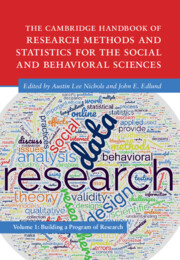 The Cambridge Handbook of Research Methods and Statistics for the Social and Behavioral Sciences
The Cambridge Handbook of Research Methods and Statistics for the Social and Behavioral Sciences from Part I - From Idea to Reality: The Basics of Research
Published online by Cambridge University Press: 25 May 2023
This chapter discusses the key elements involved when building a study. Planning empirical studies presupposes a decision about whether the major goal of the study is confirmatory (i.e., tests of hypotheses) or exploratory in nature (i.e., development of hypotheses or estimation of effects). Focusing on confirmatory studies, we discuss problems involved in obtaining an appropriate sample, controlling internal and external validity when designing the study, and selecting statistical hypotheses that mirror the substantive hypotheses of interest. Building a study additionally involves decisions about the to-be-employed statistical test strategy, the sample size required by this strategy to render the study informative, and the most efficient way to achieve this so that study costs are minimized without compromising the validity of inferences. Finally, we point to the many advantages of study preregistration before data collection begins.
To save this book to your Kindle, first ensure [email protected] is added to your Approved Personal Document E-mail List under your Personal Document Settings on the Manage Your Content and Devices page of your Amazon account. Then enter the ‘name’ part of your Kindle email address below. Find out more about saving to your Kindle.
Note you can select to save to either the @free.kindle.com or @kindle.com variations. ‘@free.kindle.com’ emails are free but can only be saved to your device when it is connected to wi-fi. ‘@kindle.com’ emails can be delivered even when you are not connected to wi-fi, but note that service fees apply.
Find out more about the Kindle Personal Document Service.
To save content items to your account, please confirm that you agree to abide by our usage policies. If this is the first time you use this feature, you will be asked to authorise Cambridge Core to connect with your account. Find out more about saving content to Dropbox.
To save content items to your account, please confirm that you agree to abide by our usage policies. If this is the first time you use this feature, you will be asked to authorise Cambridge Core to connect with your account. Find out more about saving content to Google Drive.